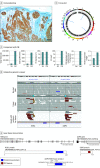Evaluation of Crizotinib Treatment in a Patient With Unresectable GOPC-ROS1 Fusion Agminated Spitz Nevi
- PMID: 34076666
- PMCID: PMC8173474
- DOI: 10.1001/jamadermatol.2021.0025
Evaluation of Crizotinib Treatment in a Patient With Unresectable GOPC-ROS1 Fusion Agminated Spitz Nevi
Abstract
Importance: Spitz nevi are benign melanocytic neoplasms that classically present in childhood. Isolated Spitz nevi have been associated with oncogenic gene fusions in approximately 50% of cases. The rare agminated variant of Spitz nevi, thought to arise from cutaneous genetic mosaicism, is characterized by development of clusters of multiple lesions in a segmental distribution, which can complicate surgical removal. Somatic single-nucleotide variants in the HRAS oncogene have been described in agminated Spitz nevi, most of which were associated with an underlying nevus spilus. The use of targeted medical therapy for agminated Spitz nevi is not well understood.
Observations: A girl aged 30 months presented with facial agminated Spitz nevi that recurred rapidly and extensively after surgery. Owing to the morbidity of further surgery, referral was made to a molecular tumor board. The patient's archival nevus tissue was submitted for extended immunohistochemical analysis and genetic sequencing. Strong ROS1 protein expression was identified by immunohistochemistry. Consistent with this, analysis of whole-genome sequencing data revealed GOPC-ROS1 fusions. These results indicated likely benefit from the oral tyrosine kinase inhibitor crizotinib, which was administered at a dosage of 280 mg/m2 twice daily. An excellent response was observed in all lesions within 5 weeks, with complete flattening after 20 weeks.
Conclusions and relevance: Given the response following crizotinib treatment observed in this case, the kinase fusion was believed to be functionally consequential in the patient's agminated Spitz nevi and likely the driver mutational event for growth of her nevi. The repurposing of crizotinib for GOPC-ROS1 Spitz nevi defines a new treatment option for these lesions, particularly in cases for which surgery is relatively contraindicated.
Conflict of interest statement
Figures



Comment in
-
Dermatology Advances Into an Era of Precision Medicine.JAMA Dermatol. 2021 Jul 1;157(7):770-772. doi: 10.1001/jamadermatol.2021.0024. JAMA Dermatol. 2021. PMID: 34076667 No abstract available.
References
-
- Goto K, Pissaloux D, Durand L, Tirode F, Guillot B, de la Fouchardière A. Novel three-way complex rearrangement of TRPM1-PUM1-LCK in a case of agminated Spitz nevi arising in a giant congenital hyperpigmented macule. Pigment Cell Melanoma Res. 2020;33(5):767-772. doi:10.1111/pcmr.12884 - DOI - PubMed
Publication types
MeSH terms
Substances
LinkOut - more resources
Full Text Sources
Medical
Research Materials
Miscellaneous

